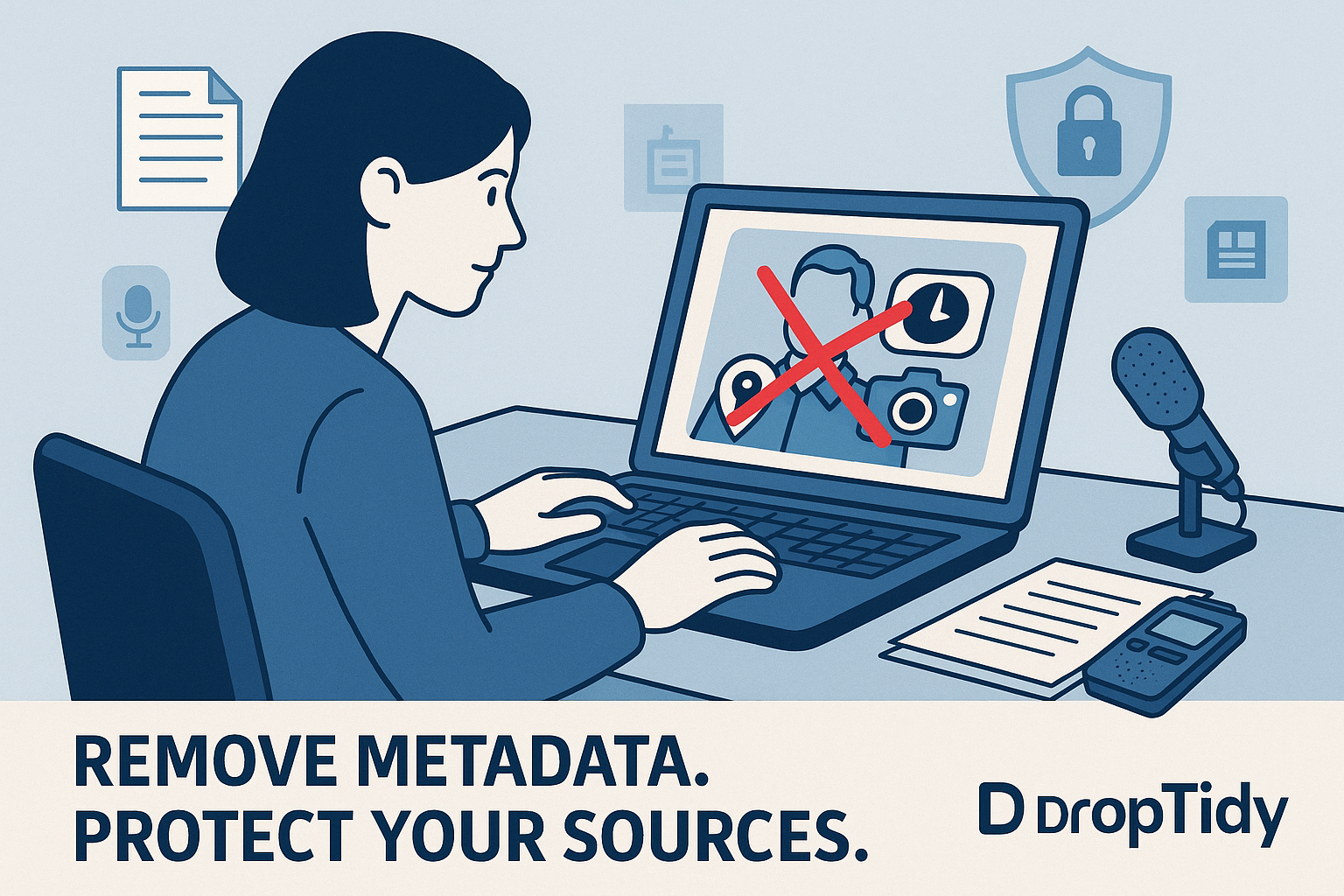Journalists: Protect Your Sources When Sharing Images
Ever shared a photo not realizing it held your source’s exact location?
Each image taken by your camera or smartphone may carry EXIF metadata—hidden info like GPS coordinates, timestamps, and camera model. These act as a digital fingerprint that risks exposing your source. If you’re a journalist, photojournalist, or media outlet covering sensitive issues, removing metadata isn’t optional—it’s essential.
In this guide, you’ll learn how to remove metadata from photos, why it matters for photo privacy, and how tools like DropTidy help maintain integrity while sharing images.

Why Photo Metadata Puts Your Sources at Risk
Metadata may seem trivial—but in the wrong hands, it's powerful:
- GPS coordinates can reveal where the photo was taken
- Timestamp shows date and time
- Camera make and model may tie images to specific users
- Editing software or device chain can expose your workflow
One journalist experienced threats after publishing a whistleblower’s image that included location data leading directly to their home.
Without proper metadata removal, such risks persist every time you share or publish a photo. (Wikipedia – Privacy concerns with social networking;
SpringerLink – Unique in the Crowd: The privacy bounds of human mobility)
What Is Image Metadata—and Why It Sticks Around
EXIF metadata is embedded automatically by devices. It typically includes:
- GPS latitude / longitude (sometimes altitude)
- Camera type, model, and even serial number
- Photo settings: ISO, shutter speed, aperture
- Timestamps and editing software fields
- Even XMP or IPTC metadata, often overlooked Cropping or resizing an image does not remove this data — unless you actively perform metadata removal. (University of Delaware (udspace.udel.edu); Litera)
How to Remove Metadata from Photos (the Right Way)
1. Use a Trusted Metadata Remover
DropTidy offers a free EXIF cleaner that works entirely in your browser. No files leave your device.
Features include:
- Full removal of EXIF, XMP, IPTC metadata
- Preview of removed data
- No installation or sign-up
- Functional on desktop and mobile browsers This ensures photo privacy, source protection, and supports safe photo sharing. (Litera – Metadata Removal Best Practices; GIJN.org – Digital Security for Journalists; SpringerLink – Metadata Privacy Risks)
2. Strip Metadata Before Publishing
Make this step standard in your editorial workflow:
- Before uploading to CMS or social media, run each image through DropTidy.
- Confirm cleaned image has no GPS, camera info, or timestamp.
- Optionally test with free metadata readers or DropTidy’s preview.
3. Automate the Habit
- Train your team and freelancers on metadata risks.
- Add metadata checks to your publication checklist.
- Bookmark DropTidy for quick access or set a browser shortcut.
Real Stories That Highlight the Risk
John McAfee’s Near-Reveal
A news outlet (Vice) published a photo with embedded GPS data, revealing John McAfee’s location in Guatemala.
He later had the metadata removed and issued a corrected image. (RSF – Resources for Journalists; Nieman Reports – Photo Metadata and Risk; WIRED – How Metadata Exposed John McAfee)
ICIJ Reporter’s Metadata Wake-Up
An ICIJ reporter realized how routinely journalists are spied on through metadata.
A source had secretively shown him his own phone metadata years ago.
It drastically changed his publishing habits. (ICIJ – How Metadata Reveals Reporters’ Secrets)
These incidents underscore why metadata removal supports journalistic ethics and source safety.
FAQ: Metadata and Source Protection
Q: Can someone track a whistleblower via a tweeted image?
A: Yes—if EXIF metadata remains in the photo, location or camera data may be extracted.
Q: Do platforms like Twitter or Instagram strip metadata?
A: Some platforms compress images and remove some metadata,
but platforms can’t be fully trusted. Always scrub before uploading.(ForestVPN – Metadata Removal Guide; Apple Discussions – Photo Metadata)
Q: Is EXIF removal enough?
A: No. Other metadata like XMP or IPTC must also be removed. DropTidy handles all common types.
Q: Can metadata removal be done without uploading images?
A: Yes—DropTidy processes images entirely in-browser with no upload or storage.
Safeguard Your Mission: How Metadata Removal Protects Your Sources
- Hides GPS location from trackers
- Removes sensitive device info that could trace images
- Ensures images are shared without revealing workflows or identities
- Builds trust with sources and colleagues
Removing metadata is a small habit with large ethical impact.
Final Thoughts
Metadata privacy is source protection. Ignoring it puts vulnerable people at risk. But tools like DropTidy make metadata removal easy, fast, and foolproof.
Make metadata cleanup a default step before publishing any image. Your sources—and your journalistic mission—deserve no less.
Ready to Protect Your Images?
👉 Try DropTidy Now – Free In‑Browser Metadata Remover
Clean your first photo before uploading.
Have you seen metadata in unexpected ways? Share your story below.